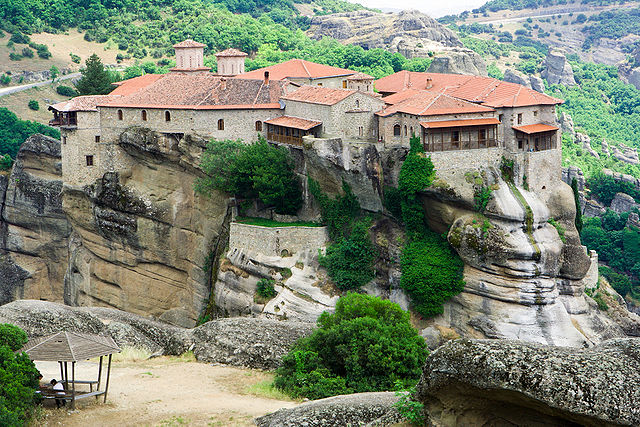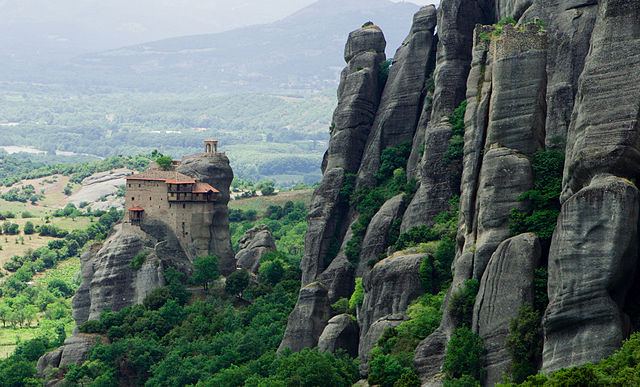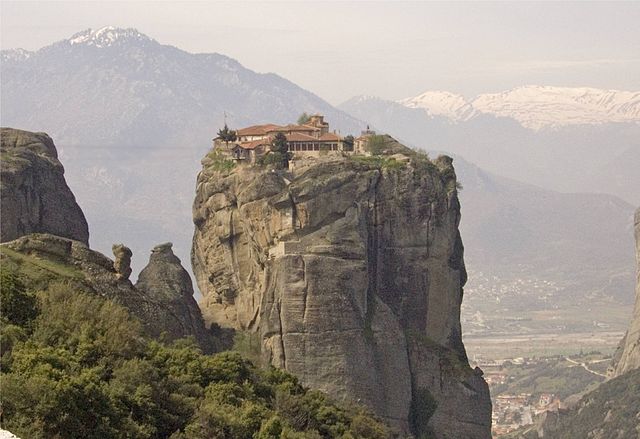 |
| photo by Wisniowy for en.wikipedia.org |
Located near the towns of Kalampaka and Kastraki in northwestern Thessaly it consists of a number of rock pinnacles topped with a total of 24 monasteries. These immense, solid rocks, split by earthquakes, weathered by water and wind over millions of years, are nature’s authentic masterpieces.
 |
| photo found on http://en.wikipedia.org |
Emerging about 60 million years ago as the elevated seabed material that was the outcome of strong tectonic movements, continuous weathering by water, wind and extremes of temperature turned them into huge pillars of rock. Much later they became shelters for men. The first hermits arrived in this area to seek spiritual isolation and inhabited the caves of these rocks, with the sole aid of ropes and ladders. Common existential needs and strong religious faith compelled them to live united in the first monastic communities, their common drive of faith guiding them towards the unique construction of monasteries of the highest architectural and artistic value.
| photo by Hencehungry for http://wikitravel.org/ |
The Meteora monasteries have been included in the UNESCO World Heritage List and the Meteora-Antichassia region has been officially declared a Natura 2000 Ecological Zone by the Greek Ministry of Environment, for the protection of its rare species of birds and flowers.
| photo by Hencehungry for http://wikitravel.org/ |
Kalampaka (also spelled Kalambaka or Kalabaka) has a population of only about 12,000 and is right at the foot of the extraordinary Meteora. There are a generous number of hotels, restaurants, shops and cafes precisely because of the economic importance of tourism to this town.
However, Kalampaka is a town with a very rich and long history itself and should not be assessed as merely sharing the glory of the Meteora pinnacles that tower over it.
On the wall of one of the town’s oldest churches, Saint John the Baptist, there's a Greek inscription about an ancient Greek settlement under the name Eginio.
Relics of an ancient Greek temple, probably for the god Apollo, have been incorporated in the wall of the town’s oldest and most renowned 10th century church, dedicated to the Virgin Mary. Historical records refer to the town’s Byzantine name as Stagi, by which time it had become a significant centre of the Byzantine Empire.
Its modern name originates from the Turkish words “kale mpak” (prestigious castle), deriving from the days of the dominion of the Ottoman Empire. During the German Occupation of Greece, Kalampaka was burnt down by the German army in 1943 and then rebuilt after the war ended.
http://www.visitmeteora.travel/about-meteora/kalampaka-town
KASTRAKI
Kastraki (meaning “small castle”) is a small, peaceful village which from afar looks like an eagle's nest at the bottom of two gigantic rocks. The village seems to pick up from right where the town of Kalampaka ends, when driving towards Meteora. Kastraki is indeed a most picturesque place with an authentic, local character. Feeling closer to the local lifestyle in the Greek province, enjoying the proximity to nature and finding peace of mind are some of the major assets of this place that urge visitors to book accommodation in this traditional, beautiful village.
The houses of the locals are mostly made of stone, embellished with roofs of clay tiles. They do not exceed a certain height, as they abide by the regulations of the National Archaeological Committee for the preservation of the village’s local characteristics and out of respect for the surrounding landscape.
The village of Kastraki has been classified by the Greek State, following a Presidential Decree, as a traditional resort under preservation, for three consecutive times! It is a pole of natural beauty and Tourism, very distinct in the wider region of Meteora, included in the list of Cultural Heritage Sites of UNESCO. The people of Kastraki share a particular affection and love for flowers. You can see flowers even in the yards of the most humble houses. Often in difficult times of the past the housewives of the locals would make flower pots out of tin cans, with which they decorated their houses and yards.
http://www.visitmeteora.travel/about-meteora/kastraki-village
GET IN
By air
You can fly from Central Europe to Volos airport in Central Greece which is located in Nea Anchialos and then travel by car for approximately two hours to Meteora. You can also take the train or bus from Volos to Kalampaka, but it will take much longer.
By bus
From Athens, the buses serving this part of the country leave from Terminal B, at Liossion Street and take about 4.5 to 5 hr so make sure you have something to amuse you!
A direct bus connection from Delphi to Meteora and Meteora to Delphi does not exist and you have to change 4 buses. You can find a shared transfer minivan from May till October offered by a Meteora travel agency.
Keep in mind that bus schedules are subject to changes or delays without prior notice.
By train
From Athens, the trains servicing the northern part of Greece leave from the "Larissa station". Train schedules can be obtained from OSC website. It's a long ride (about 4.5-5 hr), so be sure to bring a good book.
GET AROUND
You can hire a taxi right at the train station to take you to all the monasteries for about €30-40 (in 2005). However, reaching the spires by foot gives visitors a much more tangible feeling of the Meteora's majesty. It is a difficult hike, but experiencing the sanctuaries like the monks did a few hundred years ago only increases its wonder. In the summer, be prepared for the Greek heat, and as the hike takes a whole day, bring a few litres of water.
The ideal way to experience Meteora’s unique beauty is by walking. Following the words of an author of a local guide, “the slow pace of the walker gives him the chance to experience the surrounding world, where a flower, a rock or a monk standing on a high balcony are perceived quite differently. Only by following the footsteps of holy men as far in the past as the 11th century – well away from the milling crowds of tourists – is one able to experience a different aspect of Meteora”.
The sheer blocks of rock may look intimidating, but in reality walking around the area is not a difficult task. Walking is the only way to observe impressive rock formations and the shaping of strange patterns from a closer distance. Choose a pathway, like the one from the old town of Kalambaka to the monastery of Holy Trinity, or the one leading you to the ruins of old monasteries as you enter the village of Kastraki. Avoid the crowds, choose the track of your style, wear a pair of good trainers and grab your camera for an unforgettable experience!
text found on : http://wikitravel.org/en/Meteora
MONASTERIES
The Holy Monastery of Great Meteoron - This is the largest of the monasteries located at Metéora. It was erected in the mid-14th century and was the subject of restoration and embellishment projects in 1483 and 1552. The building serves as the main museum for tourists. The Katholikon (main church), consecrated in honour of the Transfiguration of Jesus was erected in the middle of 14th century and 1387/88 and decorated in 1483 and 1552.
 |
| photo by Fingalo for en.wikipedia.org |
The Holy Monastery of Varlaam – The Holy Monastery of Varlaam is the second largest monastery in the Metéora complex. It was built in 1541 and embellished in 1548. A church, dedicated to All Saints, is in the Athonite type (cross-in-square with dome and choirs), with spacious exonarthex (lite) is surrounded by a dome. It was built in 1541/42 and decorated in 1548, while the exonarthex was decorated in 1566. The old refectory is used as a museum while north of the church is the parekklesion of the Three Bishops, built in 1627 and decorated in 1637.
 | ||
| picture by Dido3 for en.wikipedia.org |
The Holy Monastery of Rousanou/St. Barbara was founded in the middle of 16th century and decorated in 1560.
 |
| photo by Dido3 for en.wikipedia.org |
The Holy Monastery of St. Nicholas Anapausas, built in the 16th century, is a small church. It was decorated by the Cretan painter Theophanis Strelitzas, in 1527.
 |
| photo by Dido3 for en.wikipedia.org |
 |
| photo by Janmad for en.wikipedia.org |
 |
| picture by Napoleon Vier at nl.wikipedia |